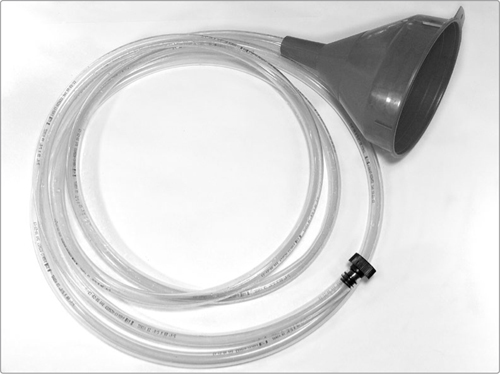
Conventional wind instruments fall into three broad groups: reed woodwinds, such as clarinets and saxophones; reedless woodwinds, such as flutes; and brass instruments, such as trumpets, tubas, bugles, and so on. This last category is a bit of a misnomer because many “brass” instruments are not made of brass: didgeridoos, for example, are considered brass instruments, as are obscure instruments like the serpent (a twisty hybrid brass-woodwind distantly related to the tuba), the Russian rozhok (an archaic wooden trumpet), the damnable plastic vuvuzela, and our own Elephant Trumpet (see Figure 3-1).
Whatever the materials, all of these “brass” instruments are labrosones: they make musical tones by harnessing the power of farty lip noises to excite a column of air.
Folks often call horns like the one we are about to build “bugles” because these ad hoc kitchen-supply instruments are valveless, and the bugle is the most common valveless brass instrument. But the Elephant Trumpet is technically a natural horn1 and closer to a trumpet or trombone than a bugle. Like a trumpet or trombone, our Elephant Trumpet has a largely cylindrical body, meaning it has a uniform diameter down most of its length. Subsequently, it has the bright, brassy, burring voice of a plus-sized trombone. In contrast, bugles, tubas, cornets, flugelhorns, French horns, shofars, and so on are fundamentally conical, with their diameter steadily increasing along their entire length, from mouthpiece to bell. This shape gives them their full, round, mellow tone.
The finished Elephant Trumpet is shown in Figure 3-1. Hear samples at http://www.nostarch.com/jamband/.

FIGURE 3-1: The finished Elephant Trumpet
Build Time
 About 5 minutes, plus 30 minutes to 24 hours of drying time for any glue
About 5 minutes, plus 30 minutes to 24 hours of drying time for any glue
 A hobby knife, utility knife, or pocketknife
A hobby knife, utility knife, or pocketknife
 A ruler or tape measure
A ruler or tape measure
 (Optional) Needle-nose pliers
(Optional) Needle-nose pliers
Supplies
 Two garden-hose quick-connect couplings (Both should have male quick-connect fittings, but one should have a male garden-hose thread and the other a female garden-hose thread. See Figure 3-3 for clarification.)
Two garden-hose quick-connect couplings (Both should have male quick-connect fittings, but one should have a male garden-hose thread and the other a female garden-hose thread. See Figure 3-3 for clarification.)
 A 2-quart funnel with an opening around 7 inches in diameter
A 2-quart funnel with an opening around 7 inches in diameter
 16 1/2 feet of 3/4-inch OD (outer diameter) × 5/8-inch ID (inner diameter) flexible vinyl tubing, or something similar that accommodates your funnel and hose coupling
16 1/2 feet of 3/4-inch OD (outer diameter) × 5/8-inch ID (inner diameter) flexible vinyl tubing, or something similar that accommodates your funnel and hose coupling
 (Optional) Duct tape or silicone-based household glue (This is also called room-temperature vulcanizing rubber, or RTV-1; the 1 means that it’s in a single tube, instead of two tubes that you have to mix together.)
(Optional) Duct tape or silicone-based household glue (This is also called room-temperature vulcanizing rubber, or RTV-1; the 1 means that it’s in a single tube, instead of two tubes that you have to mix together.)
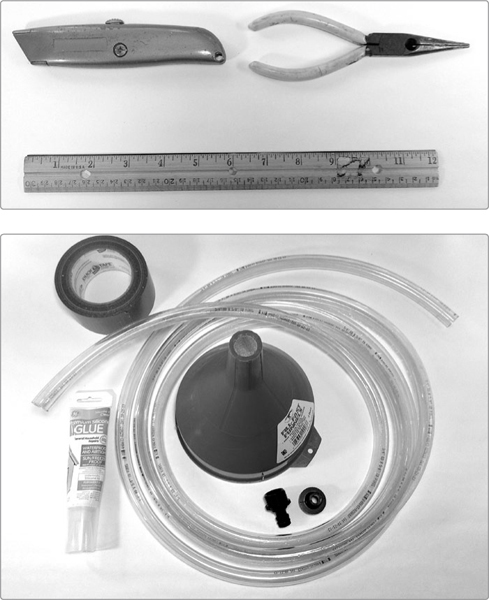
FIGURE 3-2: Tools (top) and supplies (bottom)
Step 1 Constructing a good Elephant Trumpet is an exercise in proper parts sourcing, so the first few steps will focus on finding the three major components of your trumpet. Let’s start with the mouthpiece, which you’ll make from a garden-hose quick-connect coupling. You’ll find the couplings shown in Figure 3-3 in the garden supplies aisle of the hardware store. While both have male push-connector couplings (the little end), one has a male garden-hose thread (the threads are exposed), and the other has a female garden-hose thread (the threads are concealed). I specify two couplings because different sized mouths have an easier time with different sized mouthpieces: most adults seem to favor the female-to-male coupling, while many kids have an easier time getting a good trumpet blast from the male-to-male coupling. Conveniently, these two couplings are often sold in a set together. They’re usually available in both brass and plastic, but plastic will be much more comfortable to play.
Your female-to-male connector will probably have a rubber grommet in it, and now is a good time to pull the grommet out. Needle-nose pliers will make this easier. You won’t need the grommet for this project, but it might come in handy when the washer on your garden hose goes bad, causing your outside spigot to spray water everywhere when you water the tomato plants.
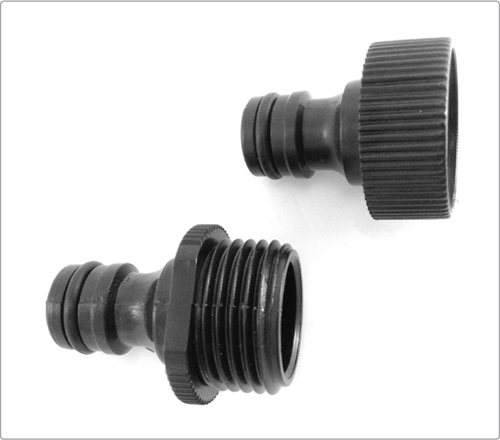
FIGURE 3-3: A pair of garden-hose quick-connect couplings: male-to-male (lower left) and female-to-male (upper right)
Step 2 Next up is the bell, which is the amplifier for your trumpet. There are two places in the hardware store you’re likely to find a 2-quart funnel: the automotive aisle and the canning or kitchen supplies aisle. Two-quart kitchen funnels tend to have long, narrow throats that will fit snuggly inside the vinyl tubing that forms the body of your trumpet. They also tend to be made of bright tin and are thus a bit pricier. You can find a cheaper plastic 2-quart funnel in the automotive aisle. Both work great, and in either case, the funnel mouth should be about 7 inches in diameter. A touch smaller or larger is fine (ranging between, say, 6 and 8 inches). Figure 3-4 shows examples of both funnel types.
If you go with a plastic funnel, it’s okay to get one with a built-in screen because the screens are pretty easy to tear out (as discussed in Step 4). But avoid metal funnels with screens, as these are usually welded in place.
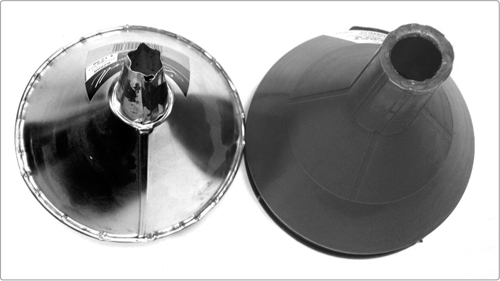
FIGURE 3-4: A 2-quart kitchen funnel (left) and an all-purpose plastic funnel (right)
Step 3 Finally, pick up about 16 1/2 feet of vinyl tubing with a 3/4-inch outer diameter and 5/8-inch inner diameter. With those dimensions, the tube should fit easily into the narrow end of a heavy-duty plastic funnel and snugly hold the smaller male end of the garden-hose quick connector, and it will also accommodate narrower-throated funnels, like the kitchen funnel. You can go with any other tubing you find that strikes your fancy and will fit both your mouthpiece and funnel, but still be sure to get at least 16 feet of it. You can always cut it down, but you can’t make it longer.
Step 4 Building your first Elephant Trumpet will take less than a minute. If the funnel you’ve chosen has a built-in screen, use needle-nose pliers to tear it out now (see Figure 3-5). Once the throat of the funnel is clear, slide the final inch of the vinyl tubing into the funnel. The tube may be snug enough to stay put on its own, but you’ll probably want to secure it with a strip of duct tape or a smear of silicone-based household glue.
FIGURE 3-5: Descreening your funnel
Step 5 Finish off your trumpet by adding the mouthpiece to the other end—but don’t glue the mouthpiece in place! Being able to easily swap out mouthpieces is a feature, not a bug. Once the glue attaching the tubing to the funnel has dried, hop to “Playing the Elephant Trumpet” on page 33 to give it a test toot. You might choose to finish your Elephant Trumpet by securing its coiled body with a few windings of duct tape, a little twine-wrapping, or even a couple of hose clamps, making it look more like the Renaissance-era natural horns the design riffs on (see Figure 3-6). I prefer to keep the tube loose, as you saw in Figure 3-1, because that makes improvising mutes and other novel effects—such as dangling the bell down a well while tooting—easier. It’s also funny to tangle lil’ trumpeteers in lengths of tubing while they blow themselves blue in the face.
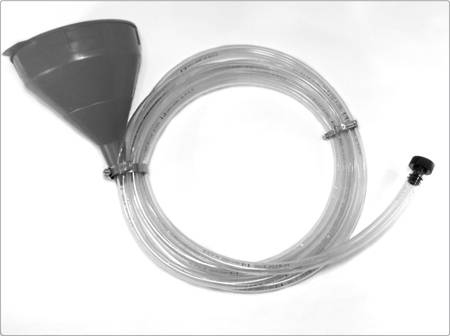
FIGURE 3-6: The finished Elephant Trumpet, coiled “natural horn” style
If you’ve never played a horn before, the Elephant Trumpet is a shockingly good place to start. The secret is to find the embouchure, or mouth shape, that works for you. You need to buzz your lips in the mouthpiece, making a sort of controlled angry-hornet-fart noise. Every human has a unique combination of mouthparts, so this can involve some fiddly experimentation. A few pointers:
 Keep your lips moist.
Keep your lips moist.
 Keep the center of your lips loose but the corners tight. Try frowning slightly.
Keep the center of your lips loose but the corners tight. Try frowning slightly.
 Place the mouthpiece so that it’s outside your lips. That is, the mouthpiece should make contact with the skin above and below your lips, not with the fleshy part you use for kissing.
Place the mouthpiece so that it’s outside your lips. That is, the mouthpiece should make contact with the skin above and below your lips, not with the fleshy part you use for kissing.
 Press your lips firmly to the mouthpiece, but don’t clamp down.
Press your lips firmly to the mouthpiece, but don’t clamp down.
 Keep your cheeks firm and flat, not ballooned out.
Keep your cheeks firm and flat, not ballooned out.
 Search embouchure on YouTube. You’ll find a lot of conflicting advice, but that’s because there are a lot of different kinds of faces.
Search embouchure on YouTube. You’ll find a lot of conflicting advice, but that’s because there are a lot of different kinds of faces.
You’ll almost certainly get the best results if you stand tall with your shoulders back, make a point of pulling your breath all the way down to your belly, and push your air out using your abs instead of your chest. To begin, pinch off the airflow through your lips by placing your tongue behind your teeth, a move horn players call stopping. Pressurize the air inside your lungs by tightening your stomach, and then release the air in a lip-buzzing burst by saying “ta.” This is basic tonguing. Practice double-tonguing (say “ta-ka” while blowing) and triple-tonguing (say “tata-ka”), too.
Try both couplings, and stick with it for a few minutes. You should get a good toot sooner rather than later. Once you’ve got that, a good first exercise is to focus on sustaining a single, unwavering pitch for as long as possible. Visualize blowing straight through the horn, rather than into it.
A natural horn like this, with its fixed length, is basically limited to playing notes that are in the harmonic series (a set of notes that are mathematically related according to their wavelength—something we’ll discuss in “Pipes and Pitches” on page 52, and touch on from a different angle in Appendix C). For example, on a bugle—which is operationally identical to our Elephant Trumpet—you can play the notes described in Table 3-1.
Tone |
1st |
2nd |
3rd |
4th |
5th |
6th |
7th |
Bugle note |
C4(middle C) |
G4 |
C5 (one octave up from middle C) |
E5 |
G5 |
B♭6 |
C6 (two octaves up from middle C) |
Given the length and width of your Elephant Trumpet, you’ll tend to get a harmonic series somewhere in the neighborhood of the one in Table 3-2.
TABLE 3-2: Elephant Trumpet Notes
Tone |
1st |
2nd |
3rd |
4th |
5th |
6th |
7th |
Approximate |
F2 |
C3 |
F3 |
A3 |
C4 |
E ♯4 |
F4 |
Elephant Trumpet note |
|||||||
Odds are that as you experiment, the first note you’ll find is the second tone, which is middle G on the bugle and usually something like a low C on an Elephant Trumpet. You can go up and down in pitch by pinching and relaxing your lips. If you relax your lips a touch, you should get that lower first tone note. If you pinch them a little, you’ll pop up to the third tone. All pitch changes can be accomplished with just lip power; avoid the temptation to modulate the pitch by squeezing the mouthpiece tighter against your lips. It’s a tricky balancing act. Focus on increasing your lip tension by pinching your lips together while still keeping them loose enough to buzz.
With a half-hour’s monkeying around, you’ll likely be able to find the fourth tone. With no prior horn experience, I can rarely hit the higher tones, so they may evade you for quite a while, too—and that’s okay: if you can hit tones 2–4, you’ve got most of what it takes to play the classic “Taps” (see Figure 3-7). Tight lips and a hearty blow will help you fake your way to that high fifth tone in the sixth bar.2
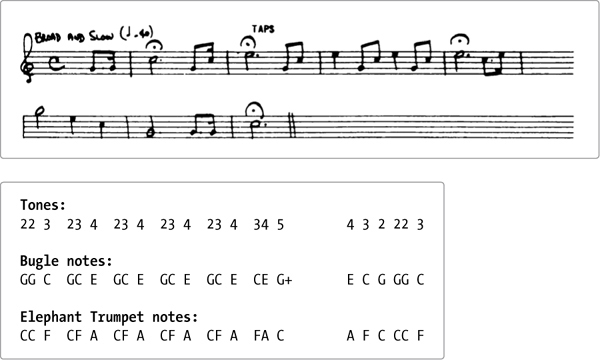
FIGURE 3-7: Sheet music (from the US Navy Manual for Buglers NAVPERS 10137-B) and several different tablatures for “Taps”
Based on woodcuts from the early 1500s, the lowest-pitched natural horns of that period appeared to be just shy of 20 feet long. As it turns out, this is a fairly fun column of air to excite; it’s in the realm of the modern tuba, which is about 16 feet long when uncoiled. This is why I chose such an extremely long length of vinyl tubing for the Elephant Trumpet.
For a brighter sound, you might consider cutting your tube down to 12 feet, like a French horn—bearing in mind that the French horn is a conical instrument, so even if you match its length, your horn’s voice will likely still be fairly different. Both the trombone and trumpet, on the other hand, are cylindrical-bore horns. When unwound, the average trombone is around 9 feet long and has a 6 1/2-inch to 8 1/2-inch bell opening. A trumpet body tube is around 6 feet long, with a 4-inch to 5-inch bell. A trumpet-like Elephant Trumpet configuration can have a body tube as short as 4 1/2 feet and still have a viable brass sound. Figure 3-8 shows a few different Elephant Trumpets with different bells and tube lengths.
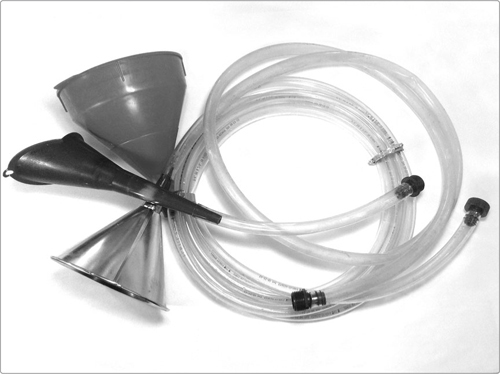
FIGURE 3-8: A variety of rubber horns
In addition to playing lower-pitched notes, a longer tube is going to give you a fuller, brassier, more sonorous tone. Shorter tubes are easier to play but sound “fartier.” A smaller bell is less loud but more defined, which is to say, it’s less rich and more like a trumpet.
There are many types of mutes for brass instruments, but the only one that really interests us is the plunger mute, which lets you actively articulate the horn’s voice by closing off and opening up the bell as you play. The plunger mute is vital to, among other effects, the infamous “sad trombone” sound effect. As its name implies, the plunger mute is conventionally made by pulling the cupped rubber end off of a brand-new toilet or sink plunger (see Figure 3-9, far left). Get a plunger with a diameter smaller than that of your horn’s bell. A similar muting technique can be accomplished with other items small enough to fit in the horn’s bell. Try disposable paper and Styrofoam coffee cups, mason jars, your closed fist or bunched fingers, and so on.
New Orleans Jazzers of the ’20s would get a more subtle effect using a Derby or bowler hat large enough to cover the opening of the bell of their horns. Try using various small cardboard boxes, kiddie sand buckets, and food storage containers in this manner. If you’ve left the coils of your Elephant Trumpet loose, you can go one further than King Oliver and Louis Armstrong by using your own belly or a big bowl of water as a mute.
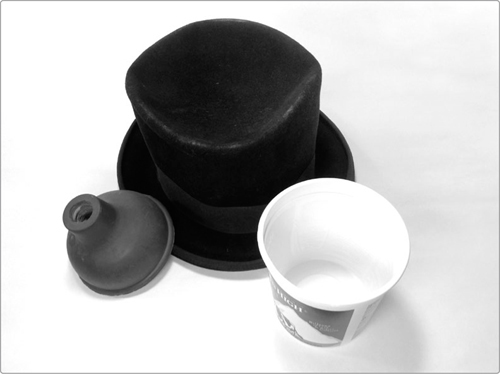
FIGURE 3-9: A variety of improvised mutes
In “Playing the Elephant Trumpet” on page 33, I gave a very brief overview of how to coax a noise out of this horn. For more details on playing, the US Navy Manual for Buglers NAVPERS 10137-B—drafted just after World War I and last revised in 1953—is a surprisingly informative source. You can find a copy online by searching for the title.